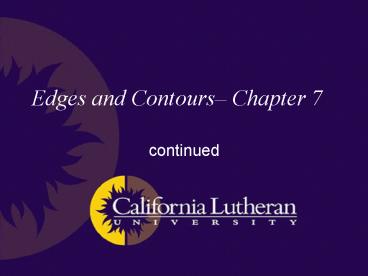Edges and Contours - PowerPoint PPT Presentation
1 / 30
Title:
Edges and Contours
Description:
Edge detection All of the previously studied edge detection filters worked on ... Gaussian filter Sobel edge detection Threshold based binarization of Sobel ... – PowerPoint PPT presentation
Number of Views:123
Avg rating:3.0/5.0
Title: Edges and Contours
1
Edges and Contours Chapter 7
- continued
2
Edge detection
- All of the previously studied edge detection
filters worked on finding local gradients (1st
derivative) - As such, all had to make decisions regarding the
actual existence of an edge based on local
information
3
Sobel edges threshold on magnitude
4
Sobel edges threshold on magnitude
- The preceding images were edge-detected with a
Sobel operator then binarized with various
thresholds - The overall trend is predictable but the
individual results are not - This threshold dependency is the curse of image
processing - Difficult to isolate real edges
- Difficult to find accurate edge location
- We need smarter algorithms
5
Scale space processing
- One method of dealing with the threshold
dependency is through scale-space processing - An image is processed at various scales
(sizes/resolution) revealing different sets of
features at each scale - Features common to all or many sets are deemed
important
6
The Gaussian Pyramid
- Select a set of Gaussian filter parameters (sigma
and width) and blur the image - Save the image
- Reduce its size by subsampling (eliminating
every other row/column) - Do it again
7
The Gaussian Pyramid
- You end up with a series of images (a pyramid)
each exposing different features - Coarse features at the top of the pyramid
- Fine features at the bottom
- You can now use the coarse features to select
where to concentrate your processing of the fine
features
8
Better (different) algorithms
- Another method of dealing with the threshold
dependency is through more complex algorithms
9
A better kernel
- The Sobel mask is a derivative mask (computes the
weighted difference of neighborhood pixels) - So is the Laplacian (negative in the middle,
positive around the rest) - From calculus the 2nd derivative of a signal is
zero when the derivative magnitude is extremal
10
A better kernel
- Combining these observations we can derive the
Laplacian-Gaussian filter due to Marr and
Hildreth - Also known as a DoG (Difference of Gaussians)
because it can be approximated by subtracting two
Gaussian kernels of same width and differing
sigmas
11
The Gaussian kernel
- Sigma 1.6, Filter Width 15
12
The Laplacian-Gaussian kernel
- Bypassing the math and jumping to the results of
applying the rules of calculus
- Similar in form to the Gaussian kernel
13
The Laplacian-Gaussian kernel
- In 1 dimension
- Can be approximated by difference of two Gaussians
14
The Laplacian-Gaussian kernel
- Convolution with this kernel results in edge
magnitudes of both positive and negative values - Were interested in where the sign changes occur
(the zero crossing) - These are where the edges are (recall the
calculus result)
15
Sobel vs. Laplacian-Gaussian
- L-G does not detect as much noise as Sobel
why not?
16
Still something missing
- What are we ignoring in the following edge
detection processes? - Gaussian filter
- Sobel edge detection
- Threshold based binarization of Sobel magnitude
- And
- Laplacian-Gaussian filter
- Zero crossing detection
17
We need a smarter algorithm
- We merely selected each edge based on its
magnitude and zero-crossing - We completely ignored its immediate surroundings
- Why is this bad?
- Detects edges we dont want
- Prone to noise
- Prone to clutter
- Doesnt detect edges we do want
- Weak magnitude edges are thresholded (thresheld?)
away - We need a smarter algorithm!
18
The Canny edge detector
- John Canny MIT 1986
- Developed a process (series of steps) for
identifying edges in an image - Gaussian smoothing of input image
- Local derivative operator to detect edge
candidates - Removal of edges that are clustered around a
single location - Adaptive thresholding algorithm for final edge
selection
19
Concepts
- Gaussian smooth original image
- Reduce the effects of noise
- Local derivative operator
- Simple neighbor pixel subtraction to detect
gradients (1st derivative) - Non-maximal suppression
- Thin out the edges around a given point
- Threshold
- Use two thresholds combined with spatial
continuity
20
Spatial continuity
- aka contour following
- Apply the high threshold to get obvious edges
- Search for a neighboring edge above the low
threshold in the direction of the strong edge - Were using a strong edge as an anchor point for
a contour of weak and strong edges known as
Hysteresis
21
Canny results
- With very conservative high/low thresholds
22
Results
All edges
Weak edges
Contours
Strong edges
23
Summary
- Through more complex processing we arrive at a
set of edges in which we have confidence - Minimal reliance on thresholds
- The cost is complex (slow, memory intensive)
processing - We must trade resources for accuracy!
24
ImageJ
- Download/install plugins for
- Sobel, Prewitt, Roberts, Kirsch, Nevatia-Babu
- Plugins-gtFeatureJ-gtEdges
- Canny implementation
25
Edge Sharpening
- An process for making an image look better
- In this case better means sharper
- The general approach is to amplify the
high-frequency components (the edges) to create a
perceived sharpness
26
Method 1 subtract 2nd derivative
- This causes a step edge to undershoot at the
bottom and overshoot at the top - The Laplacian works well for the 2nd derivative
27
ImageJ
- Note that this is difficult to do in ImageJ since
the convolution operation clamps negative pixel
values to 0
28
Unsharp mask
- Steps
- Subtract a Gaussian-smoothed version of the image
from the original creating a mask - Add a weighted version of the mask to the
original image
29
ImageJ
- Plugins-gtChapter07-gtFilter UnsharpMask
30
(No Transcript)































